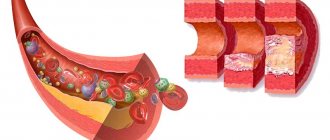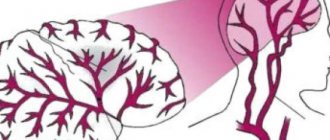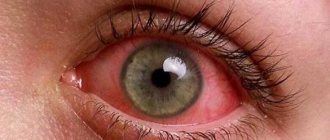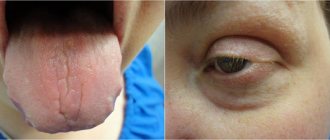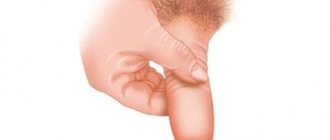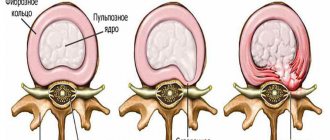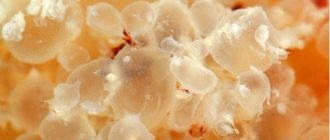Basic Concepts
Genetic predisposition is one of the causes of hypercholesterolemia.
The etiology of the disease may be associated with a genetically determined pathology, when a child inherits from his parents a defective gene associated with cholesterol synthesis (the so-called familial or primary hypercholesterolemia). In children and adolescents, the pathology often goes undiagnosed, showing its symptoms already in adulthood. The Frederickson classification of lipid metabolism disorders is generally accepted and is widely used in hematology and other areas of medicine.
The etiology of secondary hypercholesterolemia involves several factors that trigger the onset of the disease. Sometimes the catalyst for a disease is a combination of conditions, the manifestation of which is provoked by risk factors.
The forms of the disease are divided based on the etiology of its development, each of them does not have specific manifestations and other features:
- Primary hypercholesterolemia most often occurs due to a genetic failure, so it cannot be prevented. The homozygous familial form of the disease occurs when both the mother and father have abnormal genes. The frequency of occurrence is 1 case per million healthy people. The heterozygous hereditary form is caused by a defective gene of one of the parents and occurs in 90% of cases of the primary form.
- Secondary hypercholesterolemia is caused by metabolic disorders and somatic diseases.
- Nutritional hypercholesterolemia is caused by unhealthy eating habits.
Hyper- and hypocholesterolemia most often develop due to genetic mutations that occur in the human body due to the negative influence of internal and external factors. Familial hypercholesterolemia is associated with the inheritance of pathological genes that have an autosomal dominant pattern of inheritance, which leads to the encoding of low-density lipoprotein receptors.
Chronic stress often causes an acquired form of pathology.
- abuse of bad habits;
- unhealthy diet, including excessive consumption of animal fats;
- inactive, sedentary lifestyle;
- obesity;
- chronic stress, psycho-emotional overload.
High cholesterol levels can also be a consequence of uncontrolled use of certain groups of medications. This factor often causes a disorder such as hypertriglyceridemia, in which fasting triglyceride levels exceed the norm. The risk factor that becomes the trigger for the development of the disease can be any:
- age over 45 years;
- being male;
- history of cardiovascular pathologies;
- arterial hypertension;
- diabetes.
Types of hypercholesterolemia
The pathological syndrome is classified based on the reasons for its development, but the types of hypercholesterolemia do not have specific features of the course or external symptoms. There are three types of deviation:
- Primary. It is transmitted hereditarily from parents to children, is caused by gene defects and is divided into homozygous (damaged genes are inherited from the father or mother) and heterozygous form (the defective gene is inherited from one of the parents).
- Secondary. Hypercholesterolemia is formed as a result of the development of certain pathologies and abnormalities occurring in the body.
- Nutritional. Develops due to excessive consumption of foods rich in animal fats.
Pathogenesis
A deviation develops due to diseases already existing in the human body - diabetes mellitus, nephrotic syndrome. Primary hypercholesterolemia occurs due to disorders of the genetic structure. The main causes of pathological deviation are:
- Defects in the protein part of lipoproteins. This leads to the fact that LDL cannot dock with tissues and transfer chylomicrons with cholesterol to them.
- Failure of the synthesis of enzymes responsible for the transport of substances and involved in the interaction of chylomicrons with lipoproteins.
- Violation of the structure of tissue cell receptors for lipoproteins, due to which they cannot connect with each other (lipoproteins are not able to settle in a certain tissue).
Secondary hypercholesterolemia is positioned as a consequence of various acquired disorders. This includes alcoholism, dietary errors, endocrinological disorders, kidney damage, liver damage, etc. These factors lead to disruptions in the normal transport of lipids from red blood cells to tissues. The main causes of hypercholesterolemia are previously developed diseases, which can be:
- hypothyroidism;
- diabetes;
- nephrotic syndrome;
- chronic liver diseases.
The pathological condition tends to progress in the presence of certain factors in a person. There is a risk of worsening the condition if:
- hereditary predisposition (in this case, hereditary or familial hypercholesterolemia develops);
- frequent stress;
- being overweight;
- high blood pressure;
- physical inactivity;
- alcohol abuse;
- unhealthy food habits, poor nutrition.
What is hypercholesterolemia
This is not an independent nosological entity, but a pathological condition in which the level of cholesterol in the bloodstream increases. As a rule, the cause of the progression of this process is some chronic illness (diabetes mellitus, etc.). A slight increase in the amount of cholesterol does not pose a health hazard, but if the substance increases to critical levels, it threatens the development of atherosclerosis.
Pure hypercholesterolemia is labeled according to ICD 10 as E78.0, the disease belongs to the group of dysfunctions of the endocrine system and metabolism. As a rule, the pathological condition is observed in people of middle and mature age, but there are exceptions. The disease can be diagnosed in any person whose diet contains a lot of animal fats.
The biochemistry of hypercholesterolemia helps to understand the mechanism of changes. Different fats enter the human body. Due to a complex multi-step process, they are broken down and processed by enzymes. Free cholesterol does not dissolve in the blood. Light lipids in a split state are retained by red blood cells, turning into chylomicrons - transport units. Together with lymph and blood, they move throughout the body, carrying cholesterol. To get inside organs, they need the help of lipoproteins (protein and lipid complexes).
Lipoproteins stimulate the development of hypercholesterolemia. These substances have different densities. Low density units (LDL) are responsible for transporting cholesterol from the liver to organ tissue. As a rule, this function is performed by cholesterol that enters the body with food. As its amount increases, a lot of “bad” cholesterol penetrates into the cells. High-density lipoproteins (HDL) transport excess lipids from cells back to the liver. Hypercholesterolemia is formed when lipoproteins function abnormally.
When it appears
Risk factors:
- Heredity;
- Sedentary lifestyle;
- Excess body weight caused by an incorrectly formulated diet, impaired metabolism;
- Pathological eating habits, for example, addiction to cooking with lard;
- Frequent drinking of alcoholic beverages, accompanied by a large snack;
- The coincidence of several factors.
Complications
If left untreated, homozygous primary hypercholesterolemia promotes the development of atherosclerosis up to 20 years of age; the life expectancy of patients does not exceed 30 years. Untreated patients with a heterozygous form of the pathology have a high risk of developing coronary artery disease; by the age of 60, the diagnosis is confirmed in 85.5% of men and 53% of women.
People need small amounts of cholesterol in their bodies to maintain healthy cell function and hormone production. However, excessive cholesterol levels can harm your overall health and increase your risk of certain complications.
Excess cholesterol can begin to accumulate in the arteries, making them narrower. This can lead to an increased risk of heart attack and strokes.
If cholesterol deposits rupture, it can settle in the arteries around the heart, causing a heart attack.
According to the National Human Genome Research Institute, men with FH tend to have heart attacks early in life, in their 40s and 50s. It is estimated that 85% of men with this condition will have a heart attack by age 60.
Women with this condition also have an increased risk of heart attack, most often between ages 50 and 60.
If a person inherits mutated FH genes from both parents, their risk of heart attack and death before age 30 increases significantly.
In addition to an increased risk of narrowing of the arteries, a person with FH may also have aortic stenosis. This condition causes the opening of the aortic valve to narrow.
The role of the aortic valve is to open so the heart can pump oxygenated blood through the body. As a result, aortic stenosis is a serious health problem for a person with FH.
Learn about the different types and causes of heart disease here.
People need small amounts of cholesterol in their bodies to maintain healthy cell function and hormone production. However, excessive cholesterol levels can harm your overall health and increase your risk of certain complications.
Excess cholesterol can begin to accumulate in the arteries, making them narrower. This can lead to an increased risk of heart attack and strokes.
If cholesterol deposits rupture, it can settle in the arteries around the heart, causing a heart attack.
According to the National Human Genome Research Institute, men with FH tend to have heart attacks early in life, in their 40s and 50s. It is estimated that 85% of men with this condition will have a heart attack by age 60.
Women with this condition also have an increased risk of heart attack, most often between ages 50 and 60.
If a person inherits mutated FH genes from both parents, their risk of heart attack and death before age 30 increases significantly.
In addition to an increased risk of narrowing of the arteries, a person with FH may also have aortic stenosis. This condition causes the opening of the aortic valve to narrow.
The role of the aortic valve is to open so the heart can pump oxygenated blood through the body. As a result, aortic stenosis is a serious health problem for a person with FH.
Learn about the different types and causes of heart disease here.
The most dangerous and unpleasant consequence of hypercholesterolemia is atherosclerosis - the accumulation of cholesterol plaques in blood vessels, which subsequently lead to pathological changes in the wall; it loses its elasticity, which negatively affects the functioning of the entire cardiovascular system. As a result, plaques provoke a decrease in blood vessels, their occlusion, which causes a stroke or heart attack.
The chronic nature of complications of hypercholesterolemia is explained by dysfunction of the circulatory system, due to which ischemia of blood vessels and organs develops. Vascular insufficiency is the most dangerous complication, the acute nature of which is determined by vascular spasm. Heart attack and vascular rupture are common manifestations of the consequences of hypercholesterolemia.
The most dangerous consequence of hypercholesterolemia is atherosclerosis, when cholesterol plaques accumulate on the walls of blood vessels, leading to loss of elasticity and, as a result, disruption of the activity of the cardiovascular system. An increase in the size and prevalence of atherosclerotic plaques leads to narrowing and occlusion of blood vessels, the development of heart attack and stroke.
The consequence of chronic dysfunction of the circulatory system is ischemia of the arteries or organs such as the heart and brain.
The most dangerous complication is dysfunction of the circulatory system, which in acute form leads to vasospasm. The consequence of this is a heart attack with rupture of small and large vessels - typical manifestations of diseases associated with hypercholesterolemia.
The normal level of cholesterol in the blood is no more than 5.2 mmol/l (200 mg/dl). Exceeding these indicators is a reason to study the entire lipid spectrum. With increased levels of “bad” low-density and very low-density cholesterol, lifestyle adjustments are required.
Advanced hypercholesterolemia is dangerous for human health and life, as the following complications develop:
- atherosclerosis;
- vascular damage of varying degrees;
- circulatory disorders;
- vascular obstruction;
- overstretching of the aortic walls and development of an aneurysm;
- internal hemorrhage, often causing the death of the patient.
Preventive actions
To prevent provoking an increase in the cholesterol index in the blood with familial hypercholesterolemia, the following prevention is necessary:
- Quitting nicotine addiction;
- Do not drink drinks containing alcohol;
- Lead an active lifestyle and engage in active sports activities;
- Do not succumb to stressful situations and control your nervous system;
- Follow a strict diet with low cholesterol foods;
- Constant fight against obesity, hypertension;
- Constant monitoring of the glucose index.
Preventive measures should be carried out for this category of patients for life.
External signs and symptoms
A lipidogram is an uninformative laboratory indicator, since an elevated cholesterol level does not mean anything. Total cholesterol consists of triglycerides, high-density lipoproteins and low-density lipoproteins. It is important to divide this indicator into components by calculating the effect of lipoproteins of various fractions on the walls of blood vessels.
External manifestations that are critical for a specialist to make a diagnosis of secondary or genetically determined hypercholesterolemia:
- Xanthellasmas are dirty yellow formations on the eyelids located under the upper epithelium and may not be visible to a non-specialist.
- Lipoid corneal arch in a patient under 50 years of age.
- Xanthomas are formations consisting of cholesterol located above the tendons.
As the disease progresses, symptoms become severe.
Cholesterol is a representative of lipids (fats) in the blood. It is an important component of the cellular structure, as it takes part in the synthesis of hormones and energy production. An increase in cholesterol levels in the blood is called hypercholesterolemia (ICD 10). This pathological deviation is not a disease, but with prolonged high readings it can lead to the development of serious diseases.
There are two types of cholesterol: “good” and “bad”. The first is high-density lipoproteins, which protect the liver from atherosclerosis. “Bad” cholesterol has a low density, and therefore contributes to the development of vascular and heart diseases. Increased levels of two types of lipoproteins are called hypercholesterolemia. To determine the indicators, a blood sample taken on an empty stomach is used.
In numbers, hypercholesterolemia is a level of “bad” cholesterol above 3 mmol/liter, and a total level of more than 5 mmol/liter. According to statistics, such indicators are observed in 60% of our compatriots. The diagnosis of “pure hypercholesterolemia” is made to a patient when the total cholesterol level is above 5.18 mmol/liter.
Causes
Often hypercholesterolemia is a hereditary pathology. The familial form of the disorder is a consequence of the presence of a defective gene that controls cholesterol. The remaining causes of hypercholesterolemia are of a diverse nature:
- abuse of food containing a lot of animal fat;
- long-term use of immunosuppressants, beta blockers, diuretics;
- regular stress, depression;
- presence of bad habits: drugs, alcohol abuse, nicotine;
- maintaining a sedentary lifestyle (hypodynamia);
- persistently high blood pressure (hypertension).
The development of hypercholesterolemia is influenced by the presence of risk factors in a person’s life. These include:
- presence in the anamnesis of diseases such as hypothyroidism, diabetes mellitus, nephrotic syndrome, instructive changes in liver function (cholelithiasis);
- gender and age predisposition: men over 45 years of age;
- people with a family history: close relatives have been diagnosed with pure hypercholesterolemia or early atherosclerosis.
Hypercholesterolemia is classified according to Fredrickson, based on the cause of the development of the pathological condition. Its varieties do not have external manifestations or any specific features of the course at an early stage. There are three types of pathology:
- Primary. Hypercholesterolemia, inherited. It can be homozygous (the defective gene is received from the mother and father) and heterozygous (the gene is passed on to one of the parents). Hypercholesterolemia in children can be observed from the moment of birth and throughout life.
- Secondary. Develops due to the presence of certain diseases.
- Nutritional. Occurs due to excessive consumption of animal fats.
With a slight deviation from the norm in cholesterol levels, no external signs of pathology are observed. Symptoms begin to appear when the pathological process transitions to a more severe form. The signs of hypercholerinemia are specific, so it is not difficult for a doctor to make a diagnosis. Main symptoms of the pathology:
- the appearance on the skin of xanthoma (dense nodules - wen), which are often localized under the tendons (the Achilles joint and the joints of the phalanges are especially affected);
- the formation of xanthelasmas (cholesterol deposits under the skin of the upper eyelid), which look like dense yellowish nodules of different sizes;
- a visual examination of the eyes reveals a lipoid corneal arch (a pathological rim of a gray or white shade).
Complications
The most unpleasant consequence of high cholesterol is the development of atherosclerosis (lipoprotein metabolism disorder). The deposition of cholesterol plaques on the vascular walls leads over time to a loss of their elasticity, which affects the functioning of the cardiovascular system. As a result, this pathological process causes a stroke or heart attack.
Diagnostics
To determine the level of cholesterol in the blood, the patient is prescribed laboratory tests. Diagnostics includes several activities:
- Anamnesis collection. The risk of lipid metabolism disorders increases if you have a history of stroke or heart attack in your relatives.
- Physical examination, blood pressure measurement, listening to the heart. It is carried out to identify xanthelasmas, xanthomas, and the presence of abnormalities in cardiovascular activity.
- Biochemical blood test, general urine test. These methods help detect inflammatory processes in the body.
- Lipidogram. The amount of various lipids (“bad” and “good” cholesterol, triglycerides) is determined. Lipid profile indicators are a criterion for the presence or absence of hypercholesterolemia.
- Genetic research. They are carried out to detect a defective gene that carries information about fat metabolism. During the study, it is possible to identify a hereditary disorder of lipid metabolism.
Reducing high cholesterol always begins with a review of nutrition and drug treatment. The patient is prescribed a low-calorie diet for hypercholesterolemia. Non-drug therapy also includes the following measures:
- weight loss;
- to give up smoking;
- moderate physical activity;
- limiting the consumption of alcoholic beverages.
Nutrition
Hypercholesterolemia is treated with a low-calorie diet, which is designed to have an anti-sclerotic effect on the body. General nutritional rules are aimed at removing excess cholesterol, the presence of necessary vitamins and microelements in food, and the development of healthy eating habits. Diet principles:
- reducing the amount of calories consumed;
- exclusion of animal fats from the diet;
- refusal to eat at night;
- limited salt intake to 3 grams/day;
- increasing the amount of plant fiber;
- refusal of fried foods;
- cooking food by steaming, oven or boiling.
You should definitely avoid eating chicken egg yolk, liver, beef brains, red and black caviar, butter, hard cheese, veal, mackerel, and chicken with skin. The diet for hypercholesterolemia is formed from the following products:
- nuts, flax seeds, sunflower seeds;
- buckwheat (kernels), oat flakes, wheat bran;
- vegetables and herbs: garlic, onions, sweet peppers, cabbage, eggplants, beans, zucchini;
- fruits: avocado, pomegranate, grapefruit, pear, lemon, mango;
- berries: gooseberries, currants;
- meat and fish products: beef, chicken fillet, turkey, lean sea and river fish.
Adjusting your diet and lifestyle does not always help lower blood cholesterol levels. A positive result can be achieved in combination with drug therapy. To stabilize the patient’s condition, the doctor prescribes the following groups of drugs:
- Statins. Suppress the production of cholesterol by the liver, reduce its intracellular concentration. Taking these drugs can cause negative changes in muscle tissue and organs of the gastrointestinal tract, so you should strictly adhere to the dosage prescribed by your doctor. Effective representatives of the statin group: Simvastatin, Lovastatin, Pravastatin.
- Bile acid sequestrants. They reduce the risk of developing vascular insufficiency by using cholesterol for its synthesis. Known drugs of the group: Colestipol, Colesevelam, Kolestyramine.
- Fibrates. They correct lipid metabolism, activate an important enzyme that accelerates fat burning - lipoprotein lipase. Among the popular ones: Clofibrate, Fenofibrate, Gemfibrozil.
- Inhibitors. They absorb cholesterol from the intestines, reducing its levels. They can be prescribed together with statins. Effective inhibitors: Ezetimibe, Ezetrol, Ineji.
Folk remedies
Basically, hypercholesterolemia is a companion to obesity and the price to pay for excessive appetite. Diet and the use of traditional medicine will help improve cholesterol levels. It should be remembered that any treatment must be coordinated with a doctor to avoid unwanted reactions of the body. Effective recipes for clean vessels:
- Milk thistle seeds. It is necessary to take 1 teaspoon daily with each meal and drink a glass of clean water. The course of treatment is 1-2 months.
- Rose hip. Clean and crushed berries need to be poured with a glass of boiling water and simmered under a closed lid for 15 minutes. After cooling, take 100 ml 2 times a day until indicators improve.
- Sandy immortelle. Pour crushed plant flowers (10 g) into 200 ml of clean water and heat in a water bath for 30 minutes. After cooling, strain and take 1 tbsp 10 minutes before meals. l. for a month.
- Celandine. Dry leaves of the plant (1 g) are poured with boiling water (250 ml). After cooling, strain and take 1 tsp. 3 times/day after meals for 7-10 days.
Prevention
To have clean blood vessels without sclerotic plaques, you must adhere to preventive measures throughout your life. Before hypercholesterolemia occurs, the patient must follow the following rules:
- normalize body weight;
- to refuse from bad habits;
- follow the recommended diet;
- exercise regularly;
- stabilize blood pressure;
- normalize blood sugar levels;
- promptly treat diseases that can provoke lipid metabolism disorders.
Diagnostics
To determine an accurate diagnosis and find out the causes of hypercholesterolemia, you need to consult a doctor. During the initial examination, the doctor pays attention to the external signs of cholesterolemia - the presence of dense nodes under the skin, the formation of a corneal arch. To make a final diagnosis, a more detailed diagnostic approach will be required, so the patient is given a referral to undergo additional techniques, which include:
- general clinical blood and urine tests;
- biochemistry for sugar, protein, creatinine and urea levels;
- lipid profile;
- immunological diagnostics;
- determination of hormonal levels;
- angiography;
- CT or MRI;
- Ultrasound with Doppler.
Based on diagnostic studies, the stage and criterion for the development of the disease are determined. The following table contains a description of norms and deviations:
What treatment is prescribed?
Effective drugs
If a patient is diagnosed with “pure hypercholesterolemia,” complex drug therapy is prescribed to reduce cholesterol levels. During treatment, it is necessary to strictly follow the doctor’s recommendations, which will help prevent serious consequences. The following groups of drugs are used:
Exogenous and endogenous cholesterolemia is often accompanied by increased blood pressure. To normalize the indicators, antihypertensive tablets are prescribed. When the cholesterol level returns to normal, the subcutaneous nodes will resolve. If this does not happen, the pathology is treated using the following methods:
- cryodestruction;
- laser removal;
- electrocoagulation;
- surgical excision.
In patients with a homozygous form of the pathology, drug treatment of hypercholesterolemia often does not have an effect. If symptoms worsen over time, a liver transplant is recommended, otherwise the prognosis for recovery worsens.
What should the diet be like?
Proper nutrition plays an important role in improving the condition and normalizing cholesterol levels. You should not eat fatty meat, smoked meats, sweets, canned meat and fish, offal, hard cheeses, butter, lard, and black coffee. Despite the restrictions, the patient’s menu must be balanced, which means that the person will not starve.
The diet for hypercholesterolemia should include the following foods:
- lean meat - poultry, veal, beef, lamb;
- sea fish, seafood;
- fresh fruits, vegetables, berries, herbs;
- dairy products;
- whole wheat bread;
- cereals
Return to contents
Therapy with folk remedies
Hypercholesterolemia can be treated using non-traditional means only after consulting a doctor. Adherents of traditional methods claim that herbal medicine has a positive effect on the condition of patients susceptible to lipid metabolism diseases. To normalize cholesterol levels, it is recommended to use the following recipe:
Homemade medicine is prepared using chopped garlic.
- Peel and chop 350 g of garlic.
- Pour a glass of alcohol over everything and leave to infuse in a dark place for 24 hours.
- Strain the finished product, take 20 drops. 3 times a day.
Return to contents
Prognosis and prevention
If the patient adheres to the doctor’s recommendations, takes prescribed medications, and also controls nutrition for hypercholesterolemia, the cholesterol level will be within acceptable normal limits. Otherwise, dangerous complications develop, leading to disability and even death.
As a preventative measure, it is recommended to increase the body’s protective functions, normalize body weight, adjust the diet, give up bad habits forever, lead a healthy, active lifestyle, and avoid stress and psycho-emotional overload. In case of characteristic symptoms, self-medication is prohibited. Only correct and timely medical care will make it possible to avoid serious complications.
A favorable course of familial hypercholesterolemia is most likely with the heterozygous type, early initiation of treatment and periodic monitoring of cholesterol levels throughout life. Due to the hereditary nature of the pathology, it is impossible to prevent its development. Preventive measures are aimed at early diagnosis of hypercholesterolemia, which reduces the likelihood of atherosclerosis, coronary artery disease, and heart attack. For this purpose, cascade screening is carried out - a study of blood lipid levels in all the patient’s immediate relatives.
At the initial stages of the development of a pathological deviation, a sufficient measure to normalize a person’s condition would be to exclude foods with “bad” cholesterol from the menu. This will help maintain its level within acceptable limits. For primary prevention of hypercholesterolemia (if it has not yet developed), the patient needs:
- exercise regularly;
- to refuse from bad habits;
- get rid of excess body weight;
- follow a diet;
- normalize the amount of sugar in the blood;
- promptly treat any other diseases;
- maintain blood pressure within normal limits;
- limit psycho-emotional stimuli.
Secondary prevention is carried out even with existing hypercholesterolemia and is needed to prevent the development of vascular diseases and other dangerous complications. It consists of conservative treatment of the deviation. The course of the pathology is affected by the level of “harmful” and “good” cholesterol in the body, so the patient should regularly monitor these indicators using laboratory tests and, if necessary, adjust their condition through diet and medication.
Causes of the pathological syndrome
Primary (familial) hypercholesterolemia is a pathology that has not yet been fully studied. Therefore, there is no remedy that would be guaranteed to prevent its occurrence.
The main causes of primary hypercholesterolemia are considered to be:
- Defects in the structural structure of lipoprotein proteins. They are not able to interact with organ cells, cholesterol cannot enter them;
- Decreased production of “transport” enzymes. A lack of cholesterol is formed in one place and its excess in another;
- Disturbances in tissue cells. They lose the ability to contact lipoproteins.
The causes of secondary hypercholesterolemia can be:
- Hypothyroidism (disorders of the thyroid gland);
- Diabetes mellitus (impairments in the “delivery” of glucose to the body’s cells);
- Obstructive hepatic pathologies (impaired bile outflow from the liver);
- Use of certain medications (diuretics, beta blockers).
Excessive consumption of animal fats is the main cause of hypercholesterolemia in the vast majority of patients.
Standard Treatments
The most informative study is the lipid spectrum, during which cholesterol is divided into “good” and “bad” and its atherogenicity coefficient is determined.
Additional research methods:
- Studying the patient’s medical history, complaints, his opinion about the causes of xanthomas and xanthellasmas;
- Determination of probable familial hypercholesterolemia, somatic diseases;
- Examination of the patient with blood pressure measurement and auscultation;
- A general blood and urine test to determine the presence of inflammation;
- Blood test for biochemistry (determination of sugar, creatinine, uric acid levels);
- Lipidogram for the presence of elevated levels of lipoproteins;
- Study of immunological status;
- Study of the genetic pattern of hereditary diseases in all family members.
Non-drug methods used in the treatment of hypercholesterolemia:
- Correction of body weight.
- An individually designed physical activity plan, taking into account existing pathologies and oxygen flow.
- Normalization of the diet: increasing the proportion of vegetables and fruits, avoiding fatty and fried foods, reducing the calorie content of the diet.
- Avoiding the use of alcohol to slow down weight gain and reduce side effects when taking medications systematically.
- Smoking ban, as nicotine increases the risk of developing heart and vascular pathologies and reduces the concentration of anti-atherogenic substances.
Nutritional Features
Prescribing a diet for hypercholesterolemia is one of the important therapeutic measures, intended to remove “bad” cholesterol and to provide an anti-sclerotic effect with the help of a specially selected diet.
The purpose of following general nutritional rules is to get used to new eating habits and normalize metabolism.
Basic principles of nutrition:
- Reducing the total amount of fat in the menu;
- Exclusion from the diet of foods high in cholesterol;
- Increasing the proportion of polyunsaturated fatty acids in the menu;
- Replacing animal fats with vegetable oils;
- Use salt to a minimum (up to 3-4 g per day);
- Including complex carbohydrates and plenty of fiber in the diet;
- Minimum intake of saturated fatty acids.
A diet designed to lower cholesterol must include vitamins, microelements and nutrients. You will have to stick to this diet for at least a month, maximizing the variety of your diet.
Liver, veal, beef brains, red and granular caviar, tongue, butter, mackerel and hard cheese, that is, foods high in cholesterol, are excluded from the menu.
What to form a diet from
Product usefulness rating:
- Fish. Even fatty varieties are beneficial, although you should consult your doctor about using fish oil.
- Meat. It is better to cook lean fillets and tenderloins from which the fat layer has been removed. The consumption of sausages, sausages and small sausages is excluded.
- Dairy products. Skim milk is recommended; other milk products are not recommended to be included in the diet.
- Nuts. They reduce cholesterol levels, but increase excess weight.
- Green tea. It has an antisclerotic effect, but does not affect body weight.
- Bran and wholemeal flour. They replace premium flour; you cannot eat baked goods, cookies, or sweets, as they contain a large amount of “bad” cholesterol.
- Cereals and porridges made from them. Prepared with skim milk, often included in the diet.
- Vegetables and fruits. Fiber is extremely useful, as it has a positive effect on the gastrointestinal tract, removes cholesterol, and fills the body with microelements.
Any alcohol is prohibited even with moderate hypercholesterolemia (up to 6.5 mmol/l). You should not drink more than 20 ml of alcoholic beverages per day, or you should completely exclude it from your diet if you have heart and vascular diseases.
The best ways to prepare dishes are boiling, stewing or baking. If you are overweight, you need to monitor the hypoglycemic index of your meals.
